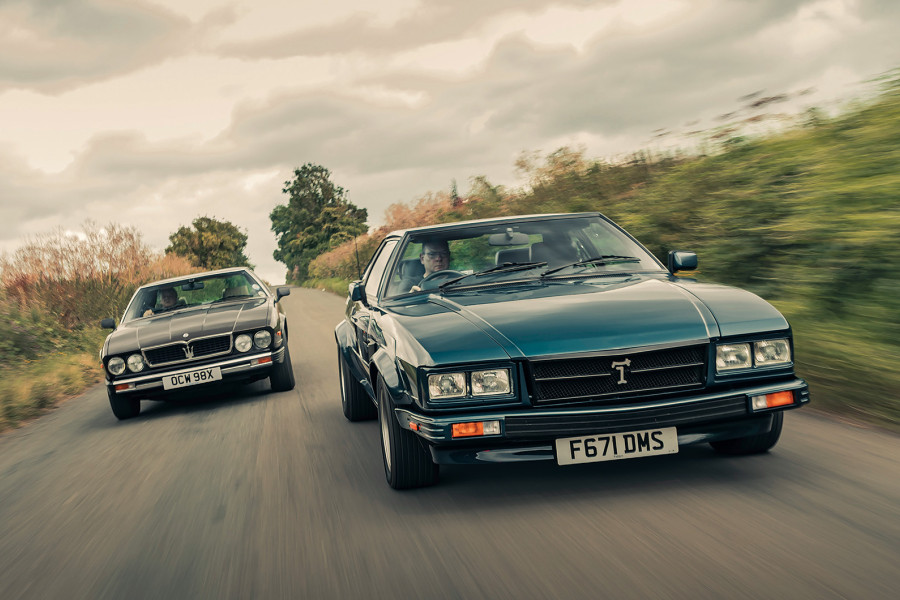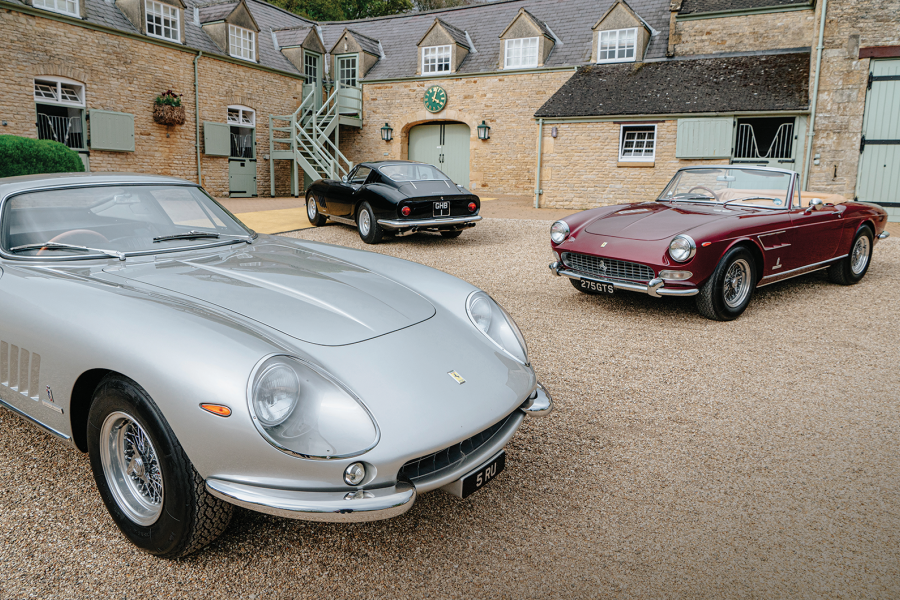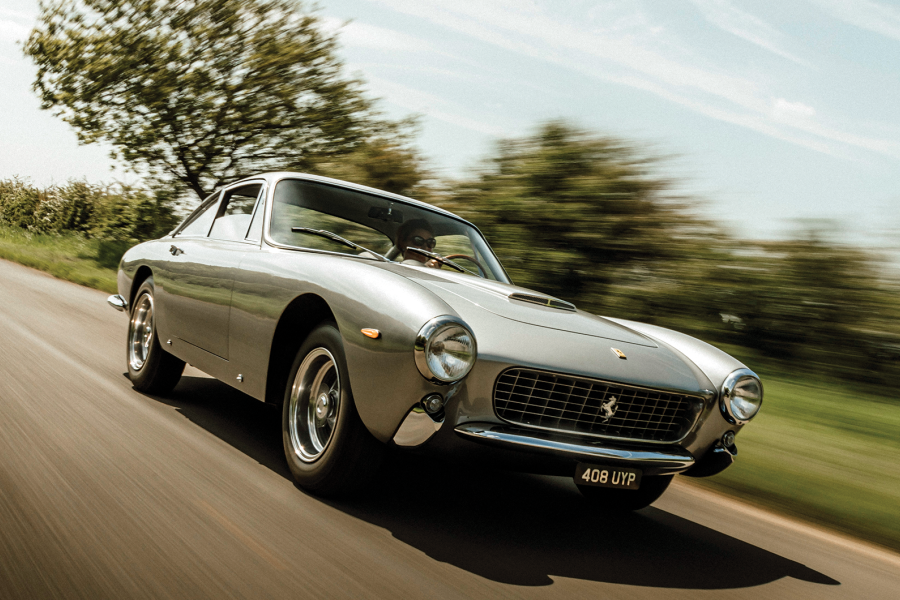There are no pauses in the delivery of power, although real pull doesn’t start until you begin piling on the revs.
It will shoot to 6000rpm in one strong, seamless lunge, with 50mph coming up in first and the other four ratios delivering 25mph each until you top out, in theory, at the 2+2’s maximum speed of 150mph.
It sounds quicker than it really is, but you can’t help being impressed, and that’s what matters.
The blood races, your spine tingles and no matter how hard you try to remain objective there is something in the sound and feel of the 365GT 2+2 that lives up to every hoary cliché you ever read about old Ferraris.
Smooth, well-adjusted controls inspire confidence behind the wheel of the Ferrari 365GT 2+2
The beautiful steering wheel is a hand’s span away from the assertive-looking gearlever, but the man-sized suspended pedals are slightly offset to the left.
The clutch is smooth and light in action, the brakes strong and you can play easy tunes on the gearbox with its positive spring-loaded centring action.
And, as I say, the power steering is superb. You can’t knock it for lack of feel and once under way you would never know it was powered.
That means you can take unexpected liberties with the 365 2+2’s handling.
The Ferrari 365GT 2+2 is much more intuitive than the Maserati Mexico and the Monteverdi 375L
This is not a transaxle Ferrari like the GTBs and GTCs but it feels balanced, neutral and forgiving for such a hefty machine.
It is also the only one of this set that you feel you can get straight into and find its limits enjoyably.
Undoubtedly there is a story to be told about the influence of chief development engineer Mike Parkes on this generation of Ferrari road cars.
The Monteverdi is without question a chariot of the gods – shark-nosed and slim-hipped, with a svelte swagger about it and a cachet of exclusivity that is unmatched among its Euro-American peers.
The Monteverdi 375L’s American V8 doesn't disappoint
From the outside, it accelerates away with just the right sort of brutish yet somehow cultivated throatiness you expect from a car that looks like this, while its bold quad-headlight front end fills a mirror like almost nothing else.
On the other side of its steeply raked windscreen, however, the problems start with the driving position.
This is one of those cars where the designer forgot that people come in a range of sizes, so unless you are rather short (like Mr Monteverdi, funnily enough), you feel that the top of the ’screen is much too close to your forehead.
Enjoyment of the Monteverdi 375L is compromised by an awkward driving position
Moreover, the absurdly lengthy steering column pokes out of the dashboard at an uncompromisingly horizontal angle (which puts the steering wheel in your lap) and the massive centre console offsets the pedals so that your arms and legs feel as if they are pointing in different directions.
The 375L dash is pleasing if you are willing to ignore the details borrowed from BMW and Mercedes, which is inevitable and doesn’t really matter.
Generally, the cabin lacks the attention to detail found in the Italian cars, but the rear seats look less of an afterthought than the others and, front or rear, there is a delightful impression of airiness in the Monteverdi.
The Monteverdi is best when you don’t make a fuss trying to kick the automatic gearbox down
The engine, with its huge fan shroud and lurid orange tappet covers, dominates the car’s personality.
It has the instant torque that just snaps the Monteverdi off the line and shoves it up the road on two gearchanges, each flicking through smoothly with minimal slur and slip.
The fascination of its performance is that you don’t have to work hard for it, and any kickdown activity or gear-selector antics amount to superfluous tomfoolery.
Windows up, it floats along serenely at three figures, very stable and steady.
The Monteverdi 375L’s driving position is so badly compromised because its engine is mounted very far back
The pay-off for mounting the engine so far back – thus compromising the driving position so badly – is that the 375L does not feel its weight in corners, steers surprisingly neutrally and has less of a sensation of body roll from the inside than it displays on the outside.
But, in the end, it’s no Ferrari, or even a Maserati. Rather, it feels like an intriguing collection of bits that never quite add up to their sum, or to the promise of its styling.
In contrast, the 365 behaves the way it does because it is an engineering entity, the influence of each component balanced against the other to produce a car that was the carefully considered result of 30 years of experience.
Compelling arguments can be made for each car, but the Monteverdi 375L’s rarity is an undeniable advantage
The likeable Mexico is a gentlemanly machine – special enough to be covetable but not so finicky that you couldn’t live with it – that has something of the appeal of both Ferrari and Monteverdi.
Which to choose? I’m going to cop out and say I could think of good reasons for owning all of them. But then again, how often do you get the chance to buy a Monteverdi?
Images: Tony Baker
Thanks to: DD Classics; Foskers
This was originally in our December 2016 magazine; all information was correct at the date of original publication
Factfiles
Ferrari 365GT 2+2
- Sold/number built 1967-’71/800
- Construction steel tubular chassis with steel and alloy body panels
- Engine all-alloy, sohc-per-bank 4390cc 60º V12, three twin-choke Weber carbs
- Max power 320bhp @ 6600rpm
- Max torque 267Ib ft @ 5000rpm
- Transmission five-speed manual, driving rear wheels
- Suspension independent, by wishbones and coil springs front anti-roll bar rear self-levelling dampers
- Steering power-assisted ZF worm and roller
- Brakes Girling discs all round, twin circuit with servo
- Length 16ft 4in (4890mm)
- Width 5ft 10in (1790mm)
- Height 4ft 5in (1345mm)
- Wheelbase 8ft 8in (2650mm)
- Weight 3487Ib (1580kg)
- 0-60mph 7.1 secs
- Top speed 150mph
- Mpg 14
- Price new £8563
Maserati Mexico
- Sold/number built 1966-’72/485
- Construction box-section steel chassis with steel body
- Engine all-alloy, dohc-per-bank, 4136cc 90º V8, four twin-choke Weber carbs
- Max power 290bhp @ 5000rpm
- Max torque 282Ib ft @ 3800rpm
- Transmission five-speed ZF manual, driving rear wheels
- Suspension: front independent, by double wishbones, coil springs rear live axle, semi-elliptic leaf springs, radius arms; telescopics
- Steering recirculating ball
- Brakes discs, with servo
- Length 15ft 6in (4724mm)
- Width 5ft 7in (1702mm)
- Height 4ft 5in (1350mm)
- Wheelbase 9ft (2743mm)
- Weight 4034Ib (1830kg)
- 0-60mph 8 secs
- Top speed 150mph
- Mpg 14
- Price new £9765
Monteverdi 375L
- Sold/number built 1969-’76/unknown
- Construction steel chassis and body
- Engine cast-iron, overhead-valve, 7206cc 90º V8, with single Carter carburettor
- Max power 375bhp @ 4600rpm
- Max torque 481lb ft @ 3200rpm
- Transmission three-speed automatic, driving rear wheels
- Suspension: front wishbones, coil springs, anti-roll bar rear de Dion axle, Watt linkage, trailing arms; telescopic dampers f/r
- Steering power-assisted ZF worm and roller
- Brakes discs, with servo
- Length 15ft 4in (4673mm)
- Width 5ft 11in (1803mm)
- Height 4ft 2in (1270mm)
- Wheelbase 8ft 9in (2667mm)
- Weight 3665lb (1662kg)
- 0-60mph c6 secs
- Top speed 147mph
- Mpg 11
- Price new £10,450
READ MORE
Practical performance: Lamborghini Espada vs Maserati Indy vs Ferrari 365GT4 2+2
AC 428: a Cobra for the jet set
30 beautiful classic Italian coupés
Martin Buckley
Senior Contributor, Classic & Sports Car































